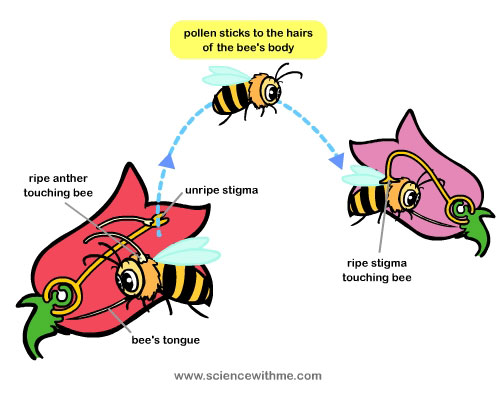Pollination is an important process in the reproduction of plants that bear seeds.
Without pollination, these plants would not be able to produce fruits! Yes, almost all the fruits that we eat and the beautiful flowers that we enjoy come from pollination! If you have seen yellow grains, sometimes white, black or green colored grains in the flowers, these are pollen that help fertilize the plants’ cells and turn these into seeds. Pollen acts as the main component in pollination, helping the flowers and plants create seeds that grow into fruits.

How does pollination work?
Pollination happens when pollen created from the plant’s male reproductive system (called the anther or stamen) is moved to the female reproductive system (called the stigma or pistil). This fertilizes the plant’s cells to produce seeds. Have you seen how bees surround your garden? If you try to observe them carefully, bees go from one flower to another as they try to gather nectar (a sugary drink) from the flowers. Nectar which turns to honey serves as food for the bees, and as the bees pass through each flower the pollen sticks from the plants’ anther onto the bees’ legs, and then gets transported to the stigma. This makes up pollination. Sometimes bees that are bred from a big colony in a huge hive also gather pollen on purpose as they collect the nectar. This makes pollination more frequent and effective in generating seeds from the plants. Most plants rely on bees and other insects or animals for pollination, although certain plants can be pollinated by wind or water.
What are the types of pollination?
There are different ways for plants to be pollinated.
- Cross-pollination is the more common way of pollination. This is the type of pollination that happens when bees travel from one plant to another, carrying and transferring pollen in the process. Other insects can also help pollination in plants. These insects are attracted to the pleasant scent and striking beauty of the flowers, so if you see gorgeous flowers with different pretty colours you can think that this is to attract insects that can help in pollination. The nectar from the flowers draw the insects towards it. Once a flower or plant is pollinated, seeds will start to sprout. Insects are also not the only animals that can aid in pollination. Some mammals and birds can also help transport pollen or seeds from one place to another, and help pollination. For some plants, pollination can occur through the help of wind or water. These plants either do not have attractive flowers or lack nectar, and are designed to have pollen transported by wind or water.
- Self-pollination is a type of pollination that does not need the help of others. Pollen grains can transfer from the stamen to the pistil by itself. These plants are fertile on their own, although you will find only a few plants that have this characteristic. Certain food plants like tomatoes belong to this category. Plants that do not need others to pollinate can produce seeds that grow into fruits faster, but to create varieties of a single type of fruit needs human intervention. Some plants that use self-pollination either have the capability to move the pollen from its stamen to its pistil, or move its pollen to the pistil of another plant.
What are pollinators?
A pollinator is a living organism or animal that helps pollination. These animals may not be aware that they are helping in pollination, but isn’t it great to know that they aid in this function? Animals that help plants in pollination include insects such as bees, butterflies, moths, beetles and certain other animals such as birds and bats. Flowers that have bright colors appeal to bees, so bees mostly help pollinate flowers with yellow, orange, blue or purple colors. Butterflies are nearly the same as bees, preferring flowers with intense colors such as red, yellow and orange. Although bees are also attracted to flowers with fresh and sweet odors, butterflies tend to favor flowers that have weak scents. Hummingbirds go to long, tubular flowers that allow them to get nectar. Bats are usually drawn to flowers that open only at night.
Why are bees and other insects so important?
Without bees and animals that act as pollinators, pollination will not happen. Most plants are designed for insects and animals to help transfer pollen and trigger fertilization of seeds, and cannot be pollinated by virtue of wind or water, or self-pollination. Losing pollinators will damage plants and wildlife that mostly rely on these insects and animals to grow. A thriving garden exists because of these pollinators. If bees and insects die, no one will be able to pollinate plants, and we will lose our source of food and oxygen. We need bees and other animals to help encourage pollination and help cultivate plants. Some children play with insects and kill them, not knowing that by doing this they are damaging the environment. Tell your family and friends how bees and other insects are great contributors to raising plants and make them aware of why they are important to the environment and to us.
